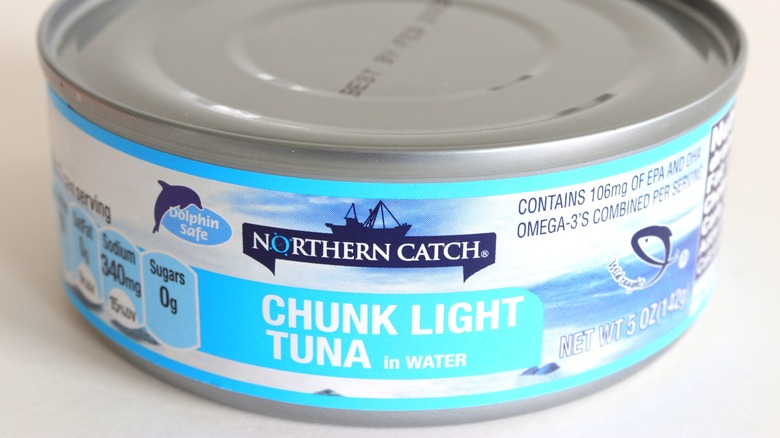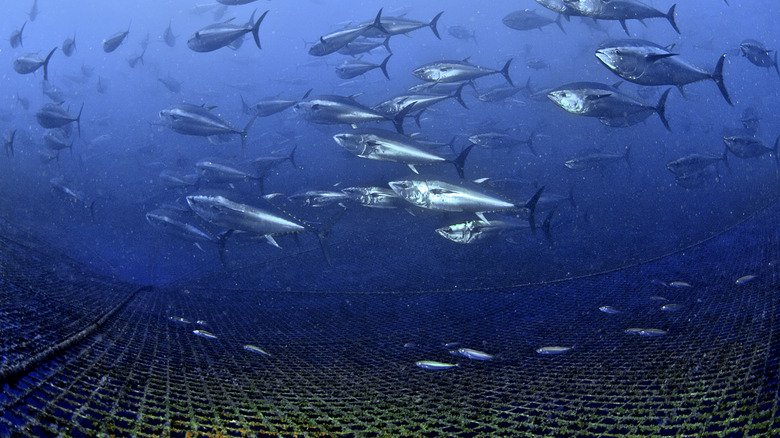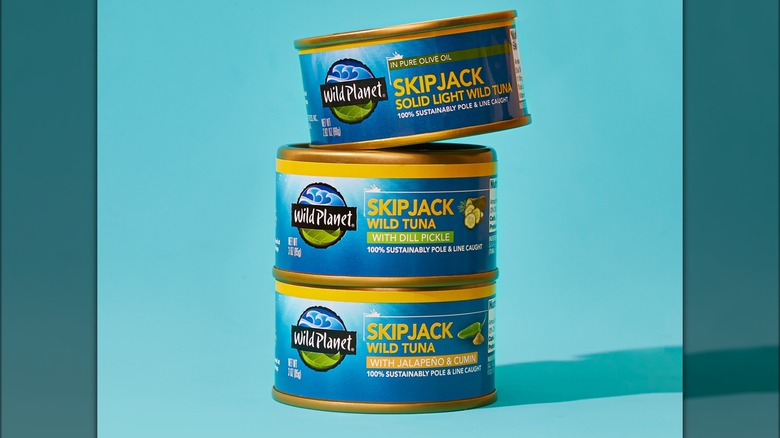What To Know About The Dolphin Safe Label On Tuna
We may receive a commission on purchases made from links.
"Dolphin Safe" appears on many labels, but understandably, you might still have questions about your canned tuna. What does the designation really mean? Are there typically dolphins in cans of this dependable protein? Well, no, but unfortunately, when fishing for tuna with large nets, dolphins are often hurt, maimed, or killed.
In an undercover operation in 1987, a biologist named Sam LaBudde captured harrowing footage of the practices used when fishing for tuna. One of the most disturbing methods was the intentional capture of dolphins. Because tuna and dolphins travel together in certain parts of the ocean, fishermen often exploit this relationship by chasing dolphins with speedboats to corral the tuna into purse seine nets or gillnets. Purse seine nets can stretch up to a mile wide and 80 feet deep, and to catch the tuna, the top edge of the net is pulled closed like a drawstring bag — dolphins sometimes also get caught as collateral. Gillnets, on the other hand, create an enormous, nearly invisible wall that catches animals as they swim through.
Ultimately, the disturbing footage sparked consumer awareness and led to a boycott of tuna. The U.S. government responded to these trends by creating the Dolphin Safe label in 1990. Instead of using the aforementioned methods, fishermen had to catch tuna using single fishing lines. Alternatively, they could still fish with large nets, but only in parts of the ocean where dolphins and tuna do not swim together.
The Dolphin Safe label is a narrow designation
Although a "vast majority" of canned tuna produced in the United States is considered Dolphin Safe, the system is far from perfect (per NOAA Fisheries). Initially, the label meant that intentionally targeting dolphins to catch tuna was prohibited, but now, this strategy and the use of purse seine nets are allowed as long as dolphins are not killed. Additionally, on-board compliance observers are no longer required, so boats using net-fishing must self-certify that they adhere to Dolphin Safe standards. This self-reporting becomes especially problematic for companies based in countries with even less oversight than the United States.
While some producers have committed to the older, more stringent rules, the understanding of what qualifies as dolphin unsafe is a little murky. This weakening of regulations has inspired less consumer confidence that dolphins are truly not being harmed during tuna fishing. Furthermore, whales, sea turtles, seals, birds, sharks, and sea lions can be accidentally caught in nets. This is known as marine bycatch, and while more intentional fishing practices can reduce it, it is still a significant problem.
More labels to look for on canned tuna
The Dolphin Safe label is just one sign of improved practices, but you can also look for canned tuna labels that specify the fishing method. "Pole-caught" and "pole-and-line caught" indicate that each fish is caught individually, which greatly minimizes the chances of ensnaring other marine life. This method is widely considered to be very sustainable. "Troll-caught" tuna is fished using lines that trail directly behind the boat. Because the lines are spaced apart and run at depths that tuna prefer, it is less likely that other animals will become tangled. However, troll lines should not be confused with problematic longlines, which stretch for miles and are lined with thousands of baited hooks.
Labels like "FAD-free," "free school," and "school caught" mean that the tuna was caught without using a fish aggregating device, where a net is suspended from a raft. Because many types of sea creatures tend to congregate under floating objects, these devices create a situation that can easily entangle other animals.
For detailed recommendations on which species of tuna, regions, and fishing methods meet the highest sustainability standards, you can consult the Seafood Watch list. Canned tuna brands such as Starkist, Chicken of the Sea, and Bumblebee are considered dolphin-safe by the International Marine Mammal Project, but do not meet the broader sustainability criteria of organizations like Seafood Watch. Brands that do meet Seafood Watch's guidelines include 365 by Whole Foods Market Albacore Tuna, Safe Catch Wild Ahi Yellowfin Tuna, and Wild Planet Skipjack Tuna.



